|
The Present Leonardtown Volunteer Fire Department
1930
By A Friend
As far back as we may wish to go is the study of strong impulse to home making. It is as natural as the man, we find everywhere and always evidence of the impulse to eat. Home is the spot to which loving memories cling. It is made sacred by the presence of those he loves most dearly. All that enables man emanates from the home. The uplift, the advancement of mankind, the progress of society, the failure or the triumph of the human race depends upon the home. Without it man is a failure, government ceases, chaos reigns. So dear to man is his home, that he devotes his best energies to its creation and maintenance; his very life is given for its preservation and protection. Undoubtedly, home is man’s most precious possession.
What a sad spectacle to see the home, the result of so much effort an solicitude, a prey to devouring flames, while man stands by, unable to rescue that which he prizes so highly. The work of a lifetime, or of several generations, succumbing to consuming fire is a pitiable sight. Prior to 1925, this community has been witness to the helplessness of man in the presence of fire.
In this year, this community having learned their lesson, measures were taken to lessen or prevent the consuming by fire of the possession dearest to man. Our people woke to the necessity of providing a water system that could be used, not only to fight fire, but to add to the comforts of living. Through the untiring efforts of our town commissioners, backed by the good will of the people, a supply of purest artesian water was found; pumping station and reservoir were established, and in February 1925, a tryout test was made, showing a pressure of 60 pounds at the fire plugs.
But, though 100,000 gallons of water stood ready at hand, there was no means of pouring it on a blazing home. Realizing this handicap, the town commissioners purchased through the Leonardtown Implement Company, 500 feet of hose. After months of waiting, this hose arrived in time to be used in what might have been a most disastrous conflagration.
July, 1925, Moakley Mattingly, amid the rejoicings of the people, brought into town, from Mechanicsville station, the long-looked-for hose. It lay on exhibition at the town green for a day. Much comment was passed from mouth to ear, and some wisdom, on the virtues of preparedness, methods of using hose, and modes of fighting fires. Little did the town’s people suspect that they would soon be called to man the hose and fight a serious fire.
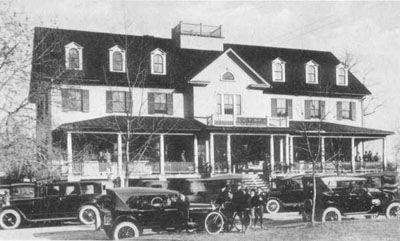
July 3, 1925, night settled quietly over Leonardtown. About 11:30, on the quiet of the town, arose the cry of fire. From mouth to mouth the message flew, that St. Mary’s Hotel was afire. A crowd gathered, and willing hands gave help with improvised ladder, bucket, and axe. Making no headway by the old method, someone thought of the new hose. A coupling was made, but disorder and lack of fire-fighting knowledge made efforts unavailing. The mayor called on Washington and Hyattsville for help. Both departments generously responded. Meanwhile, the townspeople heroically fought the blaze that threatened to break away, and under a strong south breeze, to menace the main residential part of the town. Had it not been for the help of the town water pressure and the timely hose, it would have been impossible to save Leonardtown from being, that eventful Fourth of July, a heap of ruins. As it was, the faithful fighters had conquered the blaze before the arrival of the apparatus from Washington and Hyattsville. By 4 A.M., Leonardtown breathed easily, for the fighters declared “all out,” and damage confined to the hotel.
To show their appreciation for the help rendered by Washington and Hyattsville, the people met in public assembly July 20. With General Wilmer as chairman and Hon. J. Allen Coad as treasurer, $200.00 was subscribed by the citizens and $100.00 given to each of the two city fire companies that helped to save the town July 3rd.
The scare of July 3rd soon passed, and with it the incentive for organizing and drilling a fire-fighting brigade. It was September before the ease-loving residents of the town began the organizing of the sorely needed fire department. The town commissioners wisely chose Dr. Charles V. Hayden for the important and difficult task of organizer. With his characteristic promptness, the Doctor at once, picked men of cooperative spirit to assist him in this new enterprise. From these picked men, Dr. Hayden appointed Claude Hayden, Chief; Roland B. Duke, Assistant; Henry Combs, Secretary; Stephen M. Jones, Treasurer; Frank Guy, Captain; Henry Camalier, Lieutenant.
And so a new era began in Leonardtown. Under the urging of the Doctor, backed by his officers, the town commissioners on September 25, 1925, appointed Roland Duke, Stephen Jones and George Hamilton to consider the matter of purchasing some equipment. With little or no money, these gentlemen had certainly a task on their hands.
Messrs. Duke, Jones, and Hamilton, after some studying of the field, purchased from the Washington Commission of Taxes, what had been a horse-drawn hose wagon with two 45-gallon chemical tanks and hose for the tanks.
About this same time, the town installed a fire alarm in the form of a siren. It proved to be a capable alarm, for on quiet evenings, it has been heard as far away as the Patuxent, a distance of five miles.
On November 7th, 1925, under pressure of urging from the town commissioners, the town realized that it must make another attempt at improving its first steps in equipment. A Ford truck chassis was, for a small sum, purchased from the Leonardtown Implement Company. Under the skillful hand of Barnard Smith, the chemical tanks were mounted on the Ford chassis. The young fire-fighters now felt the joy and confidence that come with possession. They now had something more than bare hands and a few buckets. They were to have opportunity to test the creation of their own genius.
Accident soon brought about a series of events that severely tested the newly acquired apparatus as well as the mettle of the volunteers. The night of February 10, Dr. F. F. Greenwell had the distinction of being the first person to break the glass screen to the fire alarm, when he turned in the call to the fire at Joseph M. Mattingly’s residence. Men and machine responded promptly, but zero weather was worse than fire. The chemical hose froze, and a return to the bucket-brigade was the only resort. In spite of frost bitten fingers and chilled bodies, the courageous volunteers stuck to their post and saved Elmboro from destruction.
Happy in their victory, the tired firemen returned to their homes to thaw and to snatch a little sleep, but extremely cold weather is the season of fires. Four o’clock the next afternoon, the siren wailed forth a call to Leonard Hall. The gymnasium was afire. So speedy was the response that damage was confined to the room in which a new heating apparatus had been installed. This same evening, men and machines were called a second time to Elmboro. The water tower was on fire and threatened the residence. On the way to this call, the truck proved inadequate to pull the steep and slippery hills. Skill and ingenuity finally won, and the chemical tanks were brought up in time to save Mr. Mattingly’s home. Leonardtown’s fire department was acquiring a full share of experience in short order. Three o’clock next morning, the thoroughly tired fighters scrambled out of bed to rush a third tome to Elmboro to protect the home and barns from a burning straw stack. Here was another triumph for the boys. All members were on the job and fought to a finish.
The period of intense activity for the department was followed by a season of quiet that lasted till March 1928. The lull had furnished opportunity for men to think and talk. March 19th, a reorganization of the department was begun. Roland B. Duke, Sr., was made Chief; Frank P. Scrivener, Captain; Barnard I. Smith, Chief Engineer; C. H. Camalier, Assistant Chief; M. T. Thrift, Assistant Engineer; John B. Sterling, Secretary. Dale Cropper and Frank Guy were appointed nozzle men; Ford Connelly and Claude Hayden became ladder men; and L. Edward Sterling took position as plug man. In this meeting was begun the effective organization that now ranks high among Maryland’s volunteer associations.
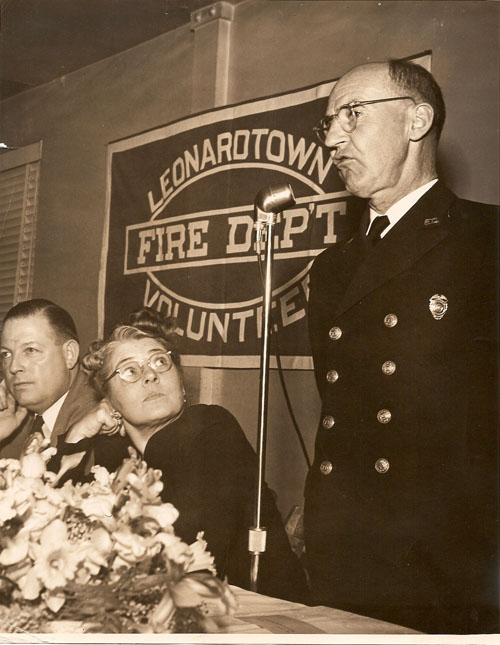
From this beginning of organized effort, with officers and men assigned to definite positions, there sprang a desire to achieve. Days of drilling and practice were appointed, experts were called in for consultation, committees were sent to other cities to study methods. Kenneth B. Duke, James E. Wheatley and John H. McNey joined the force. The Leonardtown Volunteer Fire Department became a permanent enterprise.
Enthusiasm ran high. Plans were made for raising funds to purchase proper equipment and by April 23, 1928, the public spirited brigade were able to hold their first meeting in their own newly erected fire house. The residents of Leonardtown now realized that their Volunteer Fire Department had come to stay and was a worthy asset to the community. Almost over-night, the Department found itself the pet institution of the locality. The effort to raise funds for equipment met with hearty cooperation of the people.
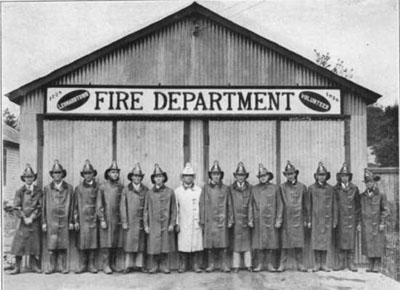
The support of the Department stirred the people to social activity. Dances were held, theatricals were presented, and card parties and dinners were given to raise funds for the “Boys.” Private donations flowed in, and something was raised by means of tag days and motion picture shows. Encouraged by this popular support, the “Boys” set to work with a will that accomplished much in a short period.
Under the supervision of Chief Engineer Smith, a Cadillac motor was welded to the Ford truck and the Department was at once in possession of an instrument that could make good time and pull its equipment to the top of any hill. Following this came the purchased helmets and rubber coats and the “Boys” looked the part when they were inspected and highly commended by the Maryland State Legislature when it visited Leonardtown, June 1st, 1928.
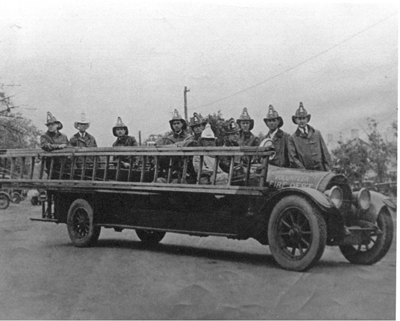
The local “Boys” had by this time been admitted to membership in the Maryland Firemen’s Association. Delegates were sent to the three days’ convention held at Elkton in June, 1928. These delegates secured the use of a Seagrave fire apparatus and participated in the public parade, where they attracted much attention by their spic and span appearance and received applause all along the line of march. The Department now realized that it had a standing and that it compared favorably with the other fire-fighting brigades of the state. The report of the delegates to the convention was most encouraging to the town “Boys” and local pride in the Department received another boost.
Public sentiment grew more favorable and the volunteers were resolved to attempt the purchase of a Seagrave outfit. Under the circumstances, the cost price of the outfit would appall most men, but it required more than this difficulty to stall the doughty Leonardtown Department. In face of discouraging odds, the business ability of the department rose to the occasion and, daring failure, the Department voted to order from the Seagrave Company, one pumper unit and appurtenances. Promptly, the apparatus arrived and was demonstrated to the town and to the County amid the rejoicings of the people in general and to the justifiable pride of the “Boys.”
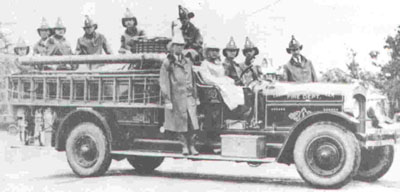
With up-to-date appliance at hand, the Department members now attended with alacrity, the weekly practice drills and eagerly awaited a call for their services. Arrangements were completed for answering fire calls from all sections of the County, so practice drills carried the members of the Company to distances of thirty miles or more from the town. In these drills, the Department gave attention to the study of water supply of the various localities, with the result that several districts, imbued with a spirit of protection, cooperated to the extent of bettering their defenses against fire, and of providing more available water supply.
The first demand upon the services of the new equipment was made November 8th, 1928, in answer to a call from St. Mary’s Academy, Leonardtown. Within two minutes of the sounding of the alarm, men and machines were at the scene of the fire; or, as the Academy authorities stated, “Having hung up the phone and walked to the front door, we found the whole Department on the lawn.: Promptness here gave added confidence to the Company and renewed feelings of security to the community. Blessings never come singly. On the 10th, a silent alarm brought the Volunteers to a burning straw stack at Cedar Point Farm. Efficient fighting methods confined damage to the stack and the “Boys” came away proud of their efforts. November 23rd, the Company answered an alarm from Great Mills. Tearing down the road at full speed, they reached the fire in twelve minutes from the sounding of the siren. This is a record response that remains to be broken.
The fire at “Cintra,” a farm owned by C. B. Greenwell, was a test of the perseverance and determination of the Leonardtown Volunteers. This fire had been raging for hours before the Volunteers were called. When the Leonardtown Boys came upon the scene, there was no water, as the well house was burning. The dwelling, a tenant house, and a barn were likewise afire, and the woods on two sides of these burning buildings was a raging furnace. Hopeless as the condition seemed to be, the “Boys” fell to fighting with a zeal that saved real-estate and household goods. During the whole of this fight, the Company was in danger of being trapped by the surrounding woods, which blazed and crackled around them as they fought to save something from the burning homes. Those who saw the Company return from this unequal battle beheld men blackened, scorched, and exhausted.
Many similar instances of heroic effort could be cited, but the recital of heroic deeds would make a long chapter. For the most part, a volunteer fire department is undervalued in the community that it pledges itself to preserve. Without salary, without reward or recognition of any kind, the volunteers hold themselves ready to assist the distressed. To this service, they willingly give their best energies. In the exercise of this broad charity they often risk health and frequently, life itself. For service of such order, a community should show its gratitude.
From the very dawn of civilization prevails the custom of erecting memorials to honor the deeds of heroes. St. Mary’s County has several such memorials to its great ones, but there is room for the erection of another testimonial to heroism. Those, who unselfishly give themselves to the work of protecting property and homes and the lives of the community from devouring flames, are indeed worthy of the highest esteem of a people. But when these same generous men hold themselves ready to answer every call of the distressed; when readily they leave business, or rush from their homes in the dead of night, in freezing weather or in parching heat, they devote their best efforts to this voluntary task; then we realize something of their superior worth. Men, who are moved by high ideals and who risk their lives, fighting to exhaustion for the success of a community, deserve that the memory of their heroic deeds be perpetuated among a grateful people. The example of such heroism should be memorialized for other generations to imitate.
True men, as the world needs them, are to be found in the Leonardtown Volunteer Fire Department; men, who, throwing all consideration of reward to the winds, give their best to a good cause, are men apart, and should be so recognized by the community they unselfishly serve.
It is fitting then, that while men of this caliber still live and serve, they should be recognized for their worth. Then, at least, let a tablet of bronze bear their names, and let it be placed in a public and permanent place that all may see, and seeing, may realize that heroes still walk the paths of life.
|